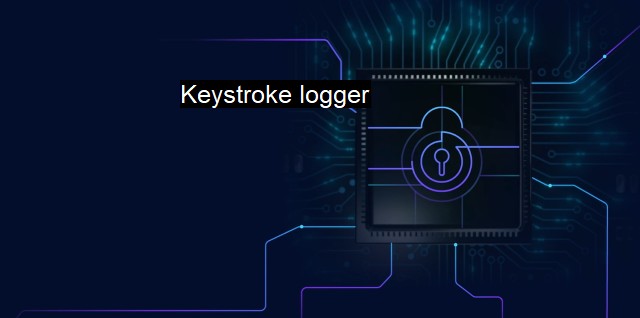What is Keystroke logger?
Keylogger Threats: Understanding Software and Hardware Keystroke Loggers and How to Protect Your System
A keystroke logger, also known as keylogger, is a type of surveillance technology used to monitor and record each keystroke typed on a specific computer's keyboard, typically in a covert manner, so that the user whose keyboard is being monitored is unaware that their activities are being tracked. Keyloggers are one of the most common types of threats that individuals, businesses, and even governments encounter in the realm of cybersecurity. Although some keylogging software is promoted for legitimate use, most are utilized for malicious purposes, such as unauthorized activity monitoring, data theft and various forms of cybercrime.Keyloggers can be either hardware- or software-based. Hardware keyloggers are physical devices that are directly plugged into the user’s keyboard or computer. Those are more organic and do not require any software installation. they can only get the information if the attacker requires to physically retrieve the device to get the stolen data, making it less applicable and likely to be discovered.
On the other hand, software-based keyloggers, considered to be the more threatening of the two, are a type of malware that can be covertly installed on one's computer. They run in the computer’s background without the user’s knowledge and capture every stroke, allowing criminals to gain unauthorized access to confidential information— password details, email communication, security keys, card numbers, internet search, and other sensitive data.
Keyloggers are appealing tools for cybercriminals because of their capacity to record every keystroke, making traditional security measures like password protection and ID verification practically hopeless, emphasizing the threats those tools pose to user privacy and financial security.
There are several strategies available for defending against keyloggers and minimizing their threat. First and foremost, a widely utilized defense mechanism against keyloggers is the use of antivirus and antispyware software. These tools provide real-time protection against potential keylogger threats by scanning and monitoring the user's system for suspicious activity. They are designed to detect and remove or isolate threats, helping to keep valuable and private data secure.
Next, the utilization of a firewall can help prevent unauthorized access into a user's computer network, serving as a protective barrier. Firewalls can detect suspicious traffic and block the source of intrusion, potentially preventing a keylogger from being installed in the system in the first place.
Keeping the system’s and programs’ updates regularly reduces the possibilities of getting affected by keyloggers, as updates always come bearing the latest fixes and security patches that address newly discovered security gaps and flaws.
Another defense against keyloggers is exercising safe browsing and avoidance of phishing scams. Users must be wary of unfamiliar websites and emails that ask for personal information, as these are frequently forms of phishing attempts that may contain keyloggers. This involves educating oneself about the common signs of scams and remaining vigilant for these tell-tale signs.
Lastly, another effective means of protection is using two-factor authentication (2FA). This adds an extra layer of security by requiring a secondary verification method, making it much more difficult for a keylogger to access the user's protected account.
Keyloggers are substantial cybersecurity threats with the potential to cause significant harm to individuals and organizations alike. It's essential to secure measures such as antivirus software, firewalls, regular updates, safe browsing habits and two-factor authentication to defend against this threat. As cybersecurity threats continue to evolve and become more complex, understand these threats and how to defend against them becomes all the more crucial.

Keystroke logger FAQs
What is a keystroke logger?
A keystroke logger, also known as a keylogger, is a software program or hardware device that records the keystrokes typed by a user on a computer keyboard. The information is typically stored in a log file and can be used to monitor a user’s activities, including passwords, credit card numbers, and other sensitive information.How can keystroke loggers be used for cybersecurity?
Keystroke loggers can be used in cybersecurity to monitor and detect malicious activities on a system. They can catch hackers attempting to steal login credentials or other sensitive data. In addition, some antivirus software programs use keystroke logging as a means of detecting and blocking suspicious activities.Is keystroke logging legal?
Keystroke logging can be legal in certain circumstances, such as when used by employers to monitor employees' computer activities during work hours, or by parents to monitor their children's online activities. However, it can also be illegal if used for malicious purposes, such as stealing personal information or spying on someone without their consent.How can I protect my computer from keystroke loggers?
To protect your computer from keystroke loggers, you can use antivirus software that includes anti-keylogging features. You can also use a virtual keyboard to enter sensitive information, which will make it more difficult for keystroke loggers to capture your keystrokes. Additionally, it's important to keep your operating system and all software programs up to date with the latest security patches and updates.| | A | | | B | | | C | | | D | | | E | | | F | | | G | | | H | | | I | | | J | | | K | | | L | | | M | |
| | N | | | O | | | P | | | Q | | | R | | | S | | | T | | | U | | | V | | | W | | | X | | | Y | | | Z | |
| | 1 | | | 2 | | | 3 | | | 4 | | | 7 | | | 8 | | |||||||